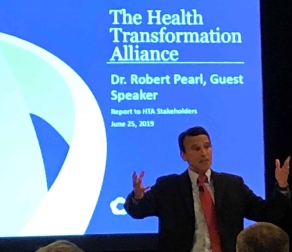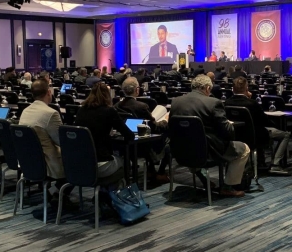As consumers, we insist on booking our flights or hotels online whenever we please. We want to check our financial statements electronically at our convenience, too. And, of course, we’d expect to know if our favorite airline, hotel chain or bank failed to meet basic expectations. Why then don’t we demand a similar level of convenience, access and transparency from healthcare?
In today’s medical climate, all three aspects of care delivery are important. But it’s transparency that has the greatest impact on clinical quality and patient safety. Patients and purchasers have the right to know when doctors and hospitals aren’t living up to basic standards of care.
Since 2000, The Leapfrog Group has striven to improve patient quality and safety by collecting, analyzing and disseminating hospital data. Founded by large employers and other purchasers, Leapfrog is the nation’s premier advocate for hospital transparency, helping purchasers find the highest-value care while giving consumers the lifesaving information they need to make informed decisions.
This week, I was honored to keynote the first-ever National Health Care Ratings Summit in Washington D.C., hosted by Leapfrog and its trailblazing CEO Leah Binder, a universally respected healthcare leader who truly understands the power of data and the importance of transparency in advancing the nation’s healthcare agenda.
The 2017 summit replaced Leapfrog’s Annual Meeting, bringing together more than 300 attendees from the world of healthcare – purchasers, providers, payers and consumer advocates – to explore best practices for creating and using consumer-friendly healthcare ratings.
There were excellent speakers on panels from some of the industry’s leading rating services and agencies, including Consumer Reports, Consumers’ Checkbook, U.S. News & World Report, the NCQA, Healthgrades, J.D. Power, and many more.
I focused my remarks on the dichotomy between what American patients see and what they get. As I wrote in my book “Mistreated: Why We Think We’re Getting Good Healthcare—And Why We’re Usually Wrong,” most patients are satisfied with the care they personally receive. It’s not uncommon to hear patients, doctors and politicians boast that America has the greatest healthcare in the world.
And yet, to date, I have not unearthed a shred of evidence to back up that claim. The United States actually trails 11 of the most industrialized nations in almost every measure of quality outcomes, including life expectancy and childhood mortality.
It’s this very common misperception that has, in large part, allowed our healthcare system to remain a 19th century cottage industry, with fragmented providers scattered throughout the community and hospitals in every town, with piecemeal payments for every service performed – what we call “fee-for-service” medicine, with technology that’s often 50 years behind the best available, and with healthcare’s legacy players, not patients and their physicians, calling the shots.
In “Mistreated,” I laud The Leapfrog Group for espousing many of the same approaches to improving clinical quality and the patient experience that are outlined in my Four Pillars Of Healthcare Transformation.
In American healthcare, as in so many parts of our lives, context shapes perception and alters our behavior. As an example of that reality, I pointed out that a third of all physicians don’t wash their hands between patients, sometimes leading to infection and death. Physicians often feel overworked with not enough time to meet all the expectations placed on them. In that context, through a subconscious shift in perception, they don’t perceive themselves as capable of spreading deadly infections from one patient to the next. It’s not that they want to spread bacteria and harm patients. And it’s not that they don’t know the risks and threats of hospital acquired infections. It’s simply that the context of their day-to-day environment shapes their perception of what is important and alters their behavior.
Leapfrog is doing pioneering work to help educate the public about the frequency of medical errors. Through its carefully selected quality and safety metrics, Leapfrog and its peers have brought these kinds of dangerous medical mistakes out of the closet and into the public discourse, spurring many healthcare providers to adopt proven approaches for avoiding systemic infection, hospital acquired pneumonia and pressure ulcers from lengthy hospital stays.
Leapfrog has also published important data on the relationship between low hospital volume and inferior patient outcomes. I offered an example of this to the audience. Along a stretch of highway in Silicon Valley – between San Jose and San Francisco – you will pass ten community hospitals that offer cardiac surgery. Three of these hospitals perform fewer than 300 heart surgeries a year. Meaning, at least 65 days out of the year, surgeons in these three hospitals perform zero operations. In any other industry, the solution would be simple: Merge the three low-volume facilities into one center of excellence. Even though there’s a direct and well-established link between higher volume and higher quality, such a change would never happen in the context of the American healthcare system. And as a result, patients are Mistreated.
It doesn’t have to be this way. It is my hope and belief that organizations like The Leapfrog Group can and will help close the gaps and continue to educate patients about what is possible today.
I closed my remarks with a challenge to the purchasers in the room.
Imagine what would happen if every major purchaser said that five years from this day in December 2022, they would no longer pay for their employees to receive medical care from physicians or hospitals that were not somehow (a) integrated, (b) prepaid at the delivery system level, (c) technologically enabled and (d) and under the leadership of strong physicians who can drive the changes necessary to improve quality. I guarantee medicine would change, both quickly and for the better.
I applaud Leapfrog for leading the way in enhancing medical excellence, patient safety and the healthcare experience. I encourage everyone to check out the group’s hospital ratings, and base their healthcare choices on the objective data they present. For those interested, please follow The Leapfrog Group on Twitter and Facebook.
Dr. Robert Pearl is the former CEO of The Permanente Medical Group, the nation’s largest physician group. He’s the bestselling author of “Mistreated: Why We Think We’re Getting Good Health Care–And Why We’re Usually Wrong” and a Stanford University professor. Follow him on Twitter @RobertPearlMD.








